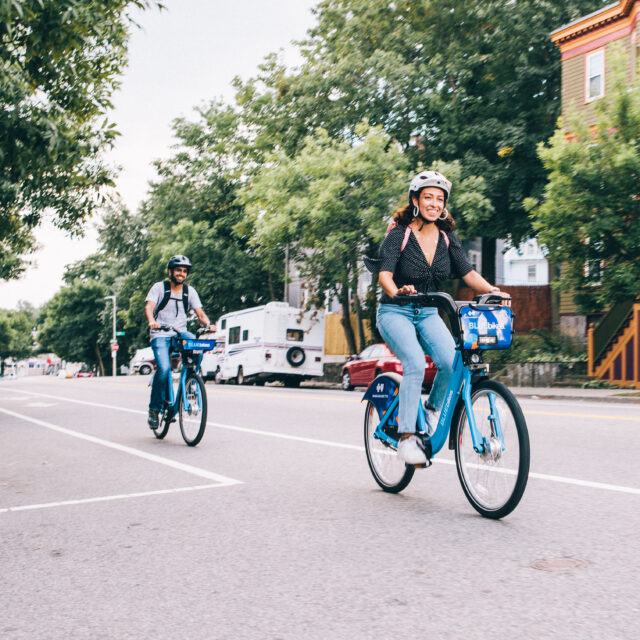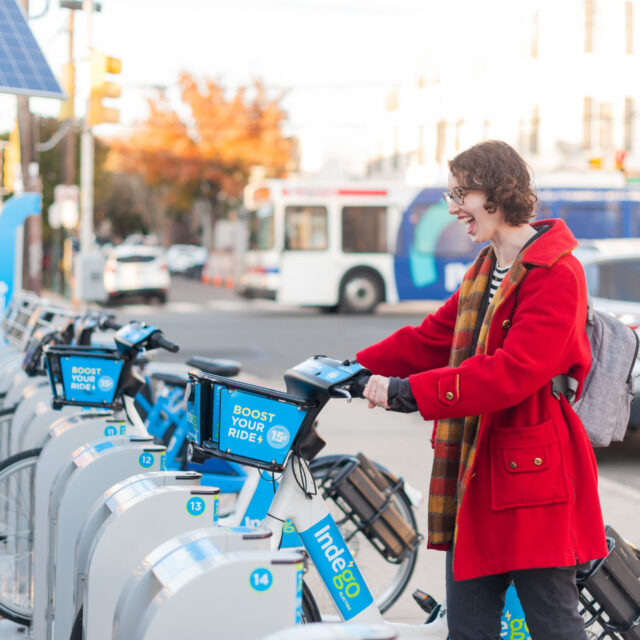What We Learned At Micromobility World 2023
by Kiran Herbert, Communications Manager
January 20, 2023
Five key lessons from the virtual, one-day conference featuring the industry’s top global builders, thinkers, and leaders.

A session featuring host Julia Thayne and Gabe Klein, executive director of the U.S. Joint Office of Energy and Transportation, discussed the “Electrification of America.”
The micromobility industry — made up of the companies that either create, fund, or support the world in which bike and scooter share operate — can sometimes give off insular vibes. Primarily white, male, and tech-adjacent, it’s a crowd that, in large part, is often associated with the “move fast and break things” maxim. Still, Micromobility World, a one-day, virtual conference run by Micromobility Industries, is a great place to take the pulse on what’s going on in the world of small, lightweight vehicles.
While equity wasn’t a focus of any of the sessions (and diversity was sorely lacking among presenters), it was mentioned by some speakers. There was, however, lots of talk about the industry’s overall trajectory and pathways to profitability. One of our biggest takeaways was that this industry isn’t thinking enough about underserved users — and if it doesn’t begin to, it won’t be nearly as successful as it could be.
Below are five other takeaways from the conference, all seen through our BBSP-specific lens.
1. We Need Better Public-Private Partnerships
(And More of Them)
This is something that we heard from panelists in multiple sessions, including in “The Electrification of America” featuring Gabe Klein, executive director of the U.S. Joint Office of Energy and Transportation, and “Bridging the Operator/City Divide,” with Zoba Cofounder Daniel Brennan and Hayden Clarkin, otherwise known as “The Transit Guy.”
According to Klein, as cities, we need to figure out what we want our mobility systems to look like, and then we need to fund them. For shared micromobility operators, that means laying out what kinds of services they can provide — cutting emissions and congestion, bridging the first/last-mile gap, encouraging mode shift, bringing mobility to underserved communities, etc. — and letting cities decide what it’s worth to help them operate (versus the model we see all too often where operators are given permits and left to do their thing).
For Klein, a true public-private partnership requires:
- Trust
- Shared Values
- Shared outcomes and incentives
- The sharing of profits and losses
In their session, Hayden and Clark echoed that sentiment, emphasizing that shared micromobility operators need to lead with societal outcomes, not profitability, aligning on results that serve public and private interests alike. If we want to help our cities achieve mode shift fast, responsibly, and equitably, then we need strong partnerships.
2. Everyone Loves E-Bikes
We already knew bike share systems that go electric bring in more users, largely by making bicycling more attractive to people of all abilities and allowing folks to bike longer distances more often. Some systems, including New York’s Citi Bike, the U.S.’s largest, even see more than twice as many e-bike rides per day than traditional bikes.
At the conference, data shared by Kersten Heineke, global leader of McKinsey & Company’s Center for Future Mobility (MCFM), only drove home the popularity of e-bikes (which also dominated just about every other conference session). According to the firm’s data, of the 70% of consumers who say they’d use micromobility for their daily commute, 40% said they’d prefer to use e-bikes.
In a separate session, we heard from Grace Rink, executive director of Denver’s Office of Climate Action, Sustainability, and Resiliency, on the city’s wildly successful e-bike rebate program. As more cities continue to follow suit (the latest being Nashville), Samantha Herr, executive director of the North American Bikeshare & Scootershare Association, says the impact will ripple down to shared micromobility. After all, as more electric vehicle charging and on-street infrastructure continues to be built out — and more riders join the fold — it should have a domino effect on bike and scooter share.
3. The Future of Shared Micromobility Looks Good
While Heineke’s session underscored the expected growth of privately-owned micromobility, it also emphasized a bright future for micromobility as a whole: By 2025, global micromobility value pools are expected to grow by 9%, reaching around $260 billion by 2025. Shared micromobility is just a fraction of the pie but it remains in sizable demand and is expected to continue to flourish, especially as more and more cities continue to invest in emission-free mobility. According to global data, 55% of consumers plan to use shared micromobility services more often in the future and 58% of consumers are satisfied with the availability of shared micromobility services in their vicinity.
This jives with the predictions of Wei Fan, director of the University of North Carolina at Charlotte’s Center for Advanced Multimodal Mobility Solutions and Education. Speaking recently with Smart Cities Dive, Fan noted that in 2023, “we’re going to see a huge increase in micromobility ownership and usage, which includes subscriptions and shared [services].” The largely attributes the growth to semiconductor shortage, rising energy prices, and growing eco-consciousness.
4. We Need Less Friction for SMM to Be Successful
The same McKinsey surveys Heineke shared spoke to how, for more than 30% of the global population, micromobility will never really cut it as a commuting solution. While that can be read in a lot of different ways, it does underscore the need for better integration between micromobility and transit. People need to be able to effectively reach essential destinations, not all of which will be short distances and will thus require a robust and affordable transit system. By integrating shared micromobility into that system, cities can cover more ground and serve more people.
Importantly, that integration needs to allow people to easily plot routes and transition between modes. In a panel discussion called “Our Car Free Tomorrow,” journalist Kara Swisher and Micromobility Industries founder Horace Dediu spoke to the need for “less friction” in the transportation landscape of the future. People need to be able to choose routes based on things like minimum cost or time spent commuting, and transitions between riding bike share and getting on a bus need to be seamless. If things aren’t made easy, most people will stick to driving.
5. Land Use Is So Important
Land is the scarcest commodity and as more people flock to urban centers, it will only become more valuable. By that logic, anything that allows us to take up less space — say, shared micromobility vehicles versus cars — is great. To drive this point home, advocates should focus on policy in order to abolish parking minimums and help remove other regulatory blockages that give preference to car owners.
“The point of transportation is to complement the built environment,” said Matthew Yglesias, senior correspondent at Vox and a featured conference speaker, “If we don’t allow the built environment to evolve, we don’t know where we can go.”
Evolution will require us to build more infrastructure so that people feel safe traveling by bike, scooter, or foot. Land use has a big impact on a lot of the things — from climate change to housing costs — that aren’t going particularly well and only contribute to inequity. To move forward in a way that serves everyone, especially the historically marginalized, we need to rethink the ways things are built.
The Better Bike Share Partnership is funded by The JPB Foundation as a collaboration between the City of Philadelphia, the National Association of City Transportation Officials (NACTO), and the PeopleForBikes Foundation to build equitable and replicable bike share systems. Follow us on LinkedIn, Facebook, Twitter, and Instagram or sign up for our weekly newsletter. Got a question or a story idea? Email kiran@peopleforbikes.org.



